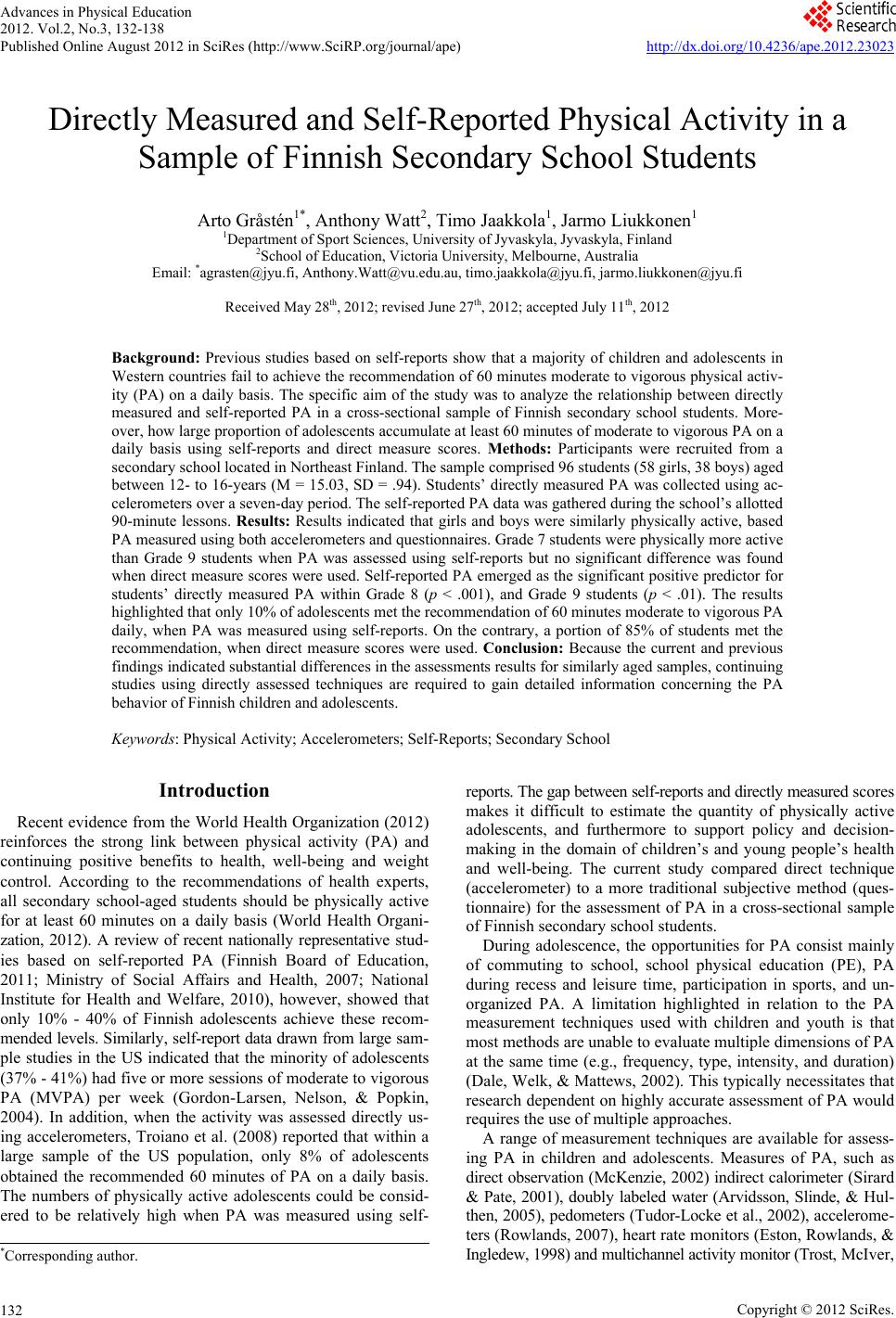 Advances in Physical Education 2012. Vol.2, No.3, 132-138 Published Online August 2012 in SciRes (http://www.SciRP.org/journal/ape) http://dx.doi.org/10.4236/ape.2012.23023 Copyright © 2012 SciRes. 132 Directly Measured and Self-Reported Physical Activity in a Sample of Finnish Secondary School Students Arto Gråstén1*, Anthony Watt2, Timo Jaakkola1, Jarmo Liukkonen1 1Department of Sport Sciences, University of Jyvaskyla, Jyvaskyla, Finland 2School of Education, Victoria University, Melbourne, Australia Email: *agrasten@jyu.fi, Anthony.Watt@vu.edu.au, timo.jaakkola@jyu.fi, jarmo.liukkonen@jyu.fi Received May 28th, 2012; revised June 27th, 2012; accepted July 11th, 2012 Background: Previous studies based on self-reports show that a majority of children and adolescents in Western countries fail to achieve the recommendation of 60 minutes moderate to vigorous physical activ- ity (PA) on a daily basis. The specific aim of the study was to analyze the relationship between directly measured and self-reported PA in a cross-sectional sample of Finnish secondary school students. More- over, how large proportion of adolescents accumulate at least 60 minutes of moderate to vigorous PA on a daily basis using self-reports and direct measure scores. Methods: Participants were recruited from a secondary school located in Northeast Finland. The sample comprised 96 students (58 girls, 38 boys) aged between 12- to 16-years (M = 15.03, SD = .94). Students’ directly measured PA was collected using ac- celerometers over a seven-day period. The self-reported PA data was gathered during the school’s allotted 90-minute lessons. Results: Results indicated that girls and boys were similarly physically active, based PA measured using both accelerometers and questionnaires. Grade 7 students were physically more active than Grade 9 students when PA was assessed using self-reports but no significant difference was found when direct measure scores were used. Self-reported PA emerged as the significant positive predictor for students’ directly measured PA within Grade 8 (p < .001), and Grade 9 students (p < .01). The results highlighted that only 10% of adolescents met the recommendation of 60 minutes moderate to vigorous PA daily, when PA was measured using self-reports. On the contrary, a portion of 85% of students met the recommendation, when direct measure scores were used. Conclusion: Because the current and previous findings indicated substantial differences in the assessments results for similarly aged samples, continuing studies using directly assessed techniques are required to gain detailed information concerning the PA behavior of Finnish children and adolescents. Keywords: Physical Activity; Accelerometers; Self-Reports; Secondary School Introduction Recent evidence from the World Health Organization (2012) reinforces the strong link between physical activity (PA) and continuing positive benefits to health, well-being and weight control. According to the recommendations of health experts, all secondary school-aged students should be physically active for at least 60 minutes on a daily basis (World Health Organi- zation, 2012). A review of recent nationally representative stud- ies based on self-reported PA (Finnish Board of Education, 2011; Ministry of Social Affairs and Health, 2007; National Institute for Health and Welfare, 2010), however, showed that only 10% - 40% of Finnish adolescents achieve these recom- mended levels. Similarly, self-report data drawn from large sam- ple studies in the US indicated that the minority of adolescents (37% - 41%) had five or more sessions of moderate to vigorous PA (MVPA) per week (Gordon-Larsen, Nelson, & Popkin, 2004). In addition, when the activity was assessed directly us- ing accelerometers, Troiano et al. (2008) reported that within a large sample of the US population, only 8% of adolescents obtained the recommended 60 minutes of PA on a daily basis. The numbers of physically active adolescents could be consid- ered to be relatively high when PA was measured using self- reports. The gap between self-reports and directly measured scores makes it difficult to estimate the quantity of physically active adolescents, and furthermore to support policy and decision- making in the domain of children’s and young people’s health and well-being. The current study compared direct technique (accelerometer) to a more traditional subjective method (ques- tionnaire) for the assessment of PA in a cross-sectional sample of Finnish secondary school students. During adolescence, the opportunities for PA consist mainly of commuting to school, school physical education (PE), PA during recess and leisure time, participation in sports, and un- organized PA. A limitation highlighted in relation to the PA measurement techniques used with children and youth is that most methods are unable to evaluate multiple dimensions of PA at the same time (e.g., frequency, type, intensity, and duration) (Dale, Welk, & Mattews, 2002). This typically necessitates that research dependent on highly accurate assessment of PA would requires the use of multiple approaches. A range of measurement techniques are available for assess- ing PA in children and adolescents. Measures of PA, such as direct observation (McKenzie, 2002) indirect calorimeter (Sirard & Pate, 2001), doubly labeled water (Arvidsson, Slinde, & Hul- then, 2005), pedometers (Tudor-Locke et al., 2002), accelerome- ters (Rowlands, 2007), heart rate monitors (Eston, Rowlands, & Ingledew, 1998) and multichannel activity monitor (Trost, McIver, *Corresponding author. 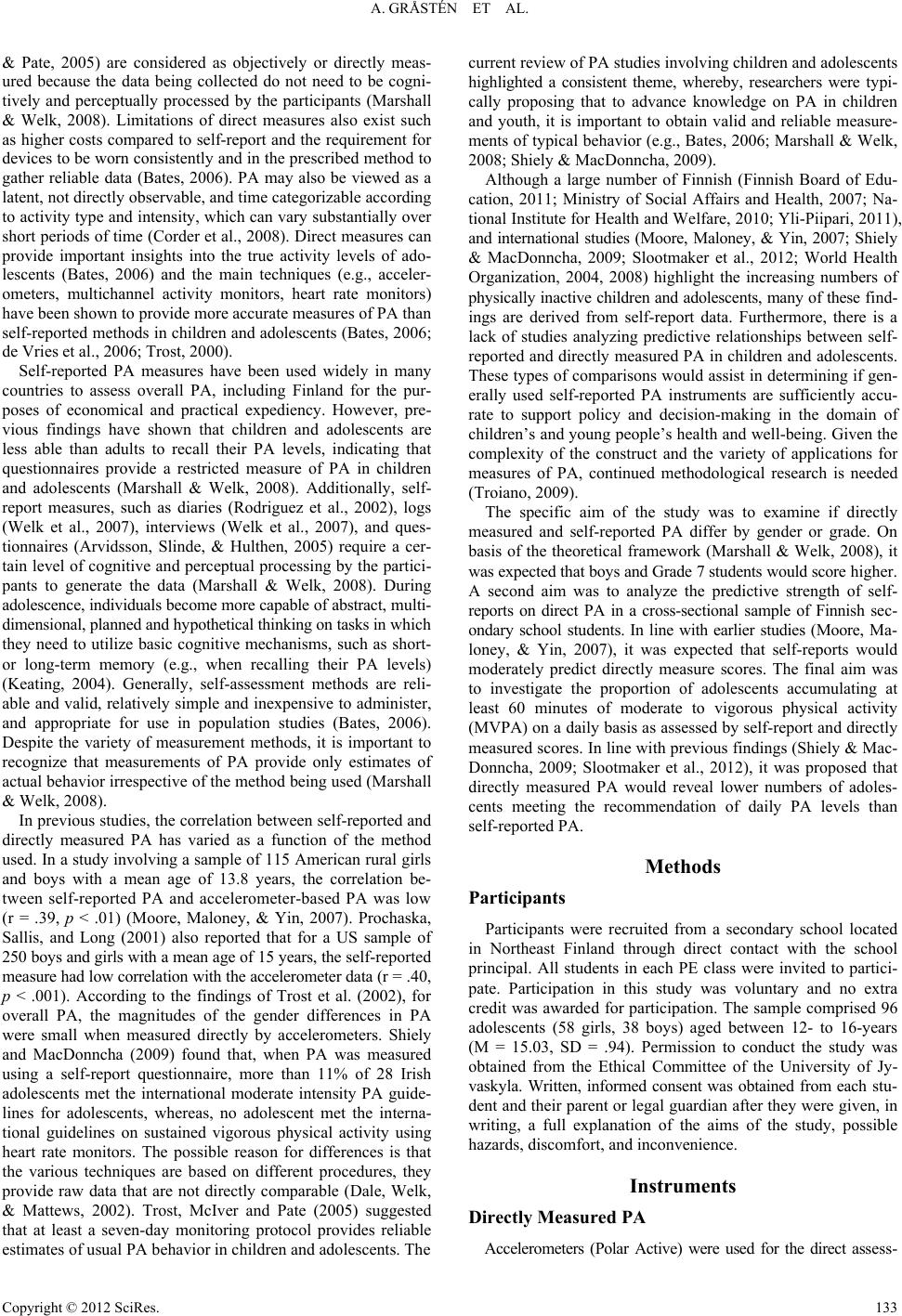 A. GRÅSTÉN ET AL. & Pate, 2005) are considered as objectively or directly meas- ured because the data being collected do not need to be cogni- tively and perceptually processed by the participants (Marshall & Welk, 2008). Limitations of direct measures also exist such as higher costs compared to self-report and the requirement for devices to be worn consistently and in the prescribed method to gather reliable data (Bates, 2006). PA may also be viewed as a latent, not directly observable, and time categorizable according to activity type and intensity, which can vary substantially over short periods of time (Corder et al., 2008). Direct measures can provide important insights into the true activity levels of ado- lescents (Bates, 2006) and the main techniques (e.g., acceler- ometers, multichannel activity monitors, heart rate monitors) have been shown to provide more accurate measures of PA than self-reported methods in children and adolescents (Bates, 2006; de Vries et al., 2006; Trost, 2000). Self-reported PA measures have been used widely in many countries to assess overall PA, including Finland for the pur- poses of economical and practical expediency. However, pre- vious findings have shown that children and adolescents are less able than adults to recall their PA levels, indicating that questionnaires provide a restricted measure of PA in children and adolescents (Marshall & Welk, 2008). Additionally, self- report measures, such as diaries (Rodriguez et al., 2002), logs (Welk et al., 2007), interviews (Welk et al., 2007), and ques- tionnaires (Arvidsson, Slinde, & Hulthen, 2005) require a cer- tain level of cognitive and perceptual processing by the partici- pants to generate the data (Marshall & Welk, 2008). During adolescence, individuals become more capable of abstract, multi- dimensional, planned and hypothetical thinking on tasks in which they need to utilize basic cognitive mechanisms, such as short- or long-term memory (e.g., when recalling their PA levels) (Keating, 2004). Generally, self-assessment methods are reli- able and valid, relatively simple and inexpensive to administer, and appropriate for use in population studies (Bates, 2006). Despite the variety of measurement methods, it is important to recognize that measurements of PA provide only estimates of actual behavior irrespective of the method being used (Marshall & Welk, 2008). In previous studies, the correlation between self-reported and directly measured PA has varied as a function of the method used. In a study involving a sample of 115 American rural girls and boys with a mean age of 13.8 years, the correlation be- tween self-reported PA and accelerometer-based PA was low (r = .39, p < .01) (Moore, Maloney, & Yin, 2007). Prochaska, Sallis, and Long (2001) also reported that for a US sample of 250 boys and girls with a mean age of 15 years, the self-reported measure had low correlation with the accelerometer data (r = .40, p < .001). According to the findings of Trost et al. (2002), for overall PA, the magnitudes of the gender differences in PA were small when measured directly by accelerometers. Shiely and MacDonncha (2009) found that, when PA was measured using a self-report questionnaire, more than 11% of 28 Irish adolescents met the international moderate intensity PA guide- lines for adolescents, whereas, no adolescent met the interna- tional guidelines on sustained vigorous physical activity using heart rate monitors. The possible reason for differences is that the various techniques are based on different procedures, they provide raw data that are not directly comparable (Dale, Welk, & Mattews, 2002). Trost, McIver and Pate (2005) suggested that at least a seven-day monitoring protocol provides reliable estimates of usual PA behavior in children and adolescents. The current review of PA studies involving children and adolescents highlighted a consistent theme, whereby, researchers were typi- cally proposing that to advance knowledge on PA in children and youth, it is important to obtain valid and reliable measure- ments of typical behavior (e.g., Bates, 2006; Marshall & Welk, 2008; Shiely & MacDonncha, 2009). Although a large number of Finnish (Finnish Board of Edu- cation, 2011; Ministry of Social Affairs and Health, 2007; Na- tional Institute for Health and Welfare, 2010; Yli-Piipari, 2011), and international studies (Moore, Maloney, & Yin, 2007; Shiely & MacDonncha, 2009; Slootmaker et al., 2012; World Health Organization, 2004, 2008) highlight the increasing numbers of physically inactive children and adolescents, many of these find- ings are derived from self-report data. Furthermore, there is a lack of studies analyzing predictive relationships between self- reported and directly measured PA in children and adolescents. These types of comparisons would assist in determining if gen- erally used self-reported PA instruments are sufficiently accu- rate to support policy and decision-making in the domain of children’s and young people’s health and well-being. Given the complexity of the construct and the variety of applications for measures of PA, continued methodological research is needed (Troiano, 2009). The specific aim of the study was to examine if directly measured and self-reported PA differ by gender or grade. On basis of the theoretical framework (Marshall & Welk, 2008), it was expected that boys and Grade 7 students would score higher. A second aim was to analyze the predictive strength of self- reports on direct PA in a cross-sectional sample of Finnish sec- ondary school students. In line with earlier studies (Moore, Ma- loney, & Yin, 2007), it was expected that self-reports would moderately predict directly measure scores. The final aim was to investigate the proportion of adolescents accumulating at least 60 minutes of moderate to vigorous physical activity (MVPA) on a daily basis as assessed by self-report and directly measured scores. In line with previous findings (Shiely & Mac- Donncha, 2009; Slootmaker et al., 2012), it was proposed that directly measured PA would reveal lower numbers of adoles- cents meeting the recommendation of daily PA levels than self-reported PA. Methods Participants Participants were recruited from a secondary school located in Northeast Finland through direct contact with the school principal. All students in each PE class were invited to partici- pate. Participation in this study was voluntary and no extra credit was awarded for participation. The sample comprised 96 adolescents (58 girls, 38 boys) aged between 12- to 16-years (M = 15.03, SD = .94). Permission to conduct the study was obtained from the Ethical Committee of the University of Jy- vaskyla. Written, informed consent was obtained from each stu- dent and their parent or legal guardian after they were given, in writing, a full explanation of the aims of the study, possible hazards, discomfort, and inconvenience. Instruments Directly Measured PA Accelerometers (Polar Active) were used for the direct assess- Copyright © 2012 SciRes. 133 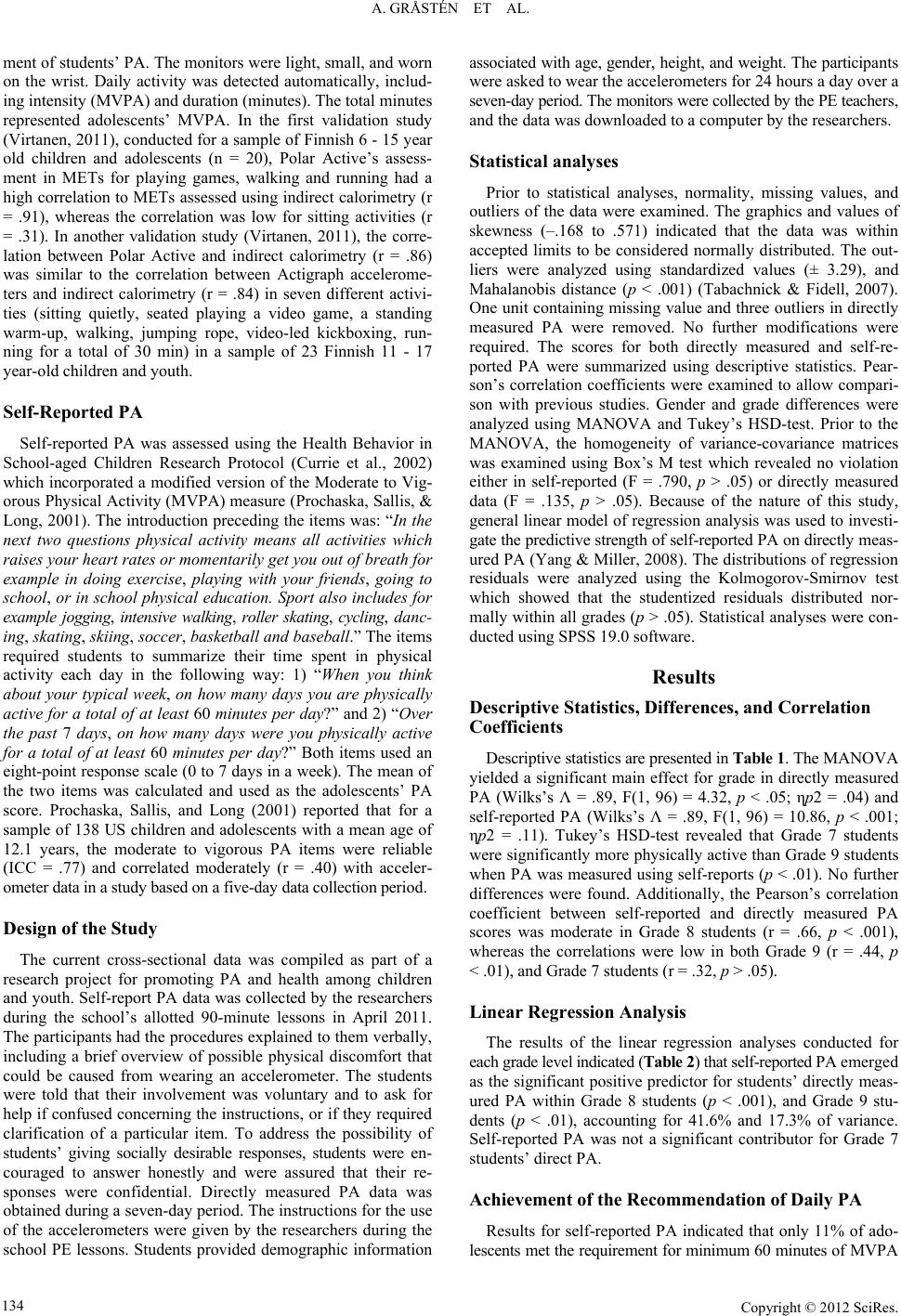 A. GRÅSTÉN ET AL. ment of students’ PA. The monitors were light, small, and worn on the wrist. Daily activity was detected automatically, includ- ing intensity (MVPA) and duration (minutes). The total minutes represented adolescents’ MVPA. In the first validation study (Virtanen, 2011), conducted for a sample of Finnish 6 - 15 year old children and adolescents (n = 20), Polar Active’s assess- ment in METs for playing games, walking and running had a high correlation to METs assessed using indirect calorimetry (r = .91), whereas the correlation was low for sitting activities (r = .31). In another validation study (Virtanen, 2011), the corre- lation between Polar Active and indirect calorimetry (r = .86) was similar to the correlation between Actigraph accelerome- ters and indirect calorimetry (r = .84) in seven different activi- ties (sitting quietly, seated playing a video game, a standing warm-up, walking, jumping rope, video-led kickboxing, run- ning for a total of 30 min) in a sample of 23 Finnish 11 - 17 year-old children and youth. Self-Reported PA Self-reported PA was assessed using the Health Behavior in School-aged Children Research Protocol (Currie et al., 2002) which incorporated a modified version of the Moderate to Vig- orous Physical Activity (MVPA) measure (Prochaska, Sallis, & Long, 2001). The introduction preceding the items was: “In the next two questions physical activity means all activities which raises your heart rates or momentarily get you out of breath for example in doing exercise, playing with your friends, going to school, or in school physical education. Sport also includes for example jogging, intensive walking, roller skating, cycling, danc- ing, skating, skiing, soccer, basketball and baseball.” The items required students to summarize their time spent in physical activity each day in the following way: 1) “When you think about your typical week, on how many days you are physically active for a total of at least 60 minutes per day?” and 2) “Over the past 7 days, on how many days were you physically active for a total of at least 60 minutes per day?” Both items used an eight-point response scale (0 to 7 days in a week). The mean of the two items was calculated and used as the adolescents’ PA score. Prochaska, Sallis, and Long (2001) reported that for a sample of 138 US children and adolescents with a mean age of 12.1 years, the moderate to vigorous PA items were reliable (ICC = .77) and correlated moderately (r = .40) with acceler- ometer data in a study based on a five-day data collection period. Design of the Study The current cross-sectional data was compiled as part of a research project for promoting PA and health among children and youth. Self-report PA data was collected by the researchers during the school’s allotted 90-minute lessons in April 2011. The participants had the procedures explained to them verbally, including a brief overview of possible physical discomfort that could be caused from wearing an accelerometer. The students were told that their involvement was voluntary and to ask for help if confused concerning the instructions, or if they required clarification of a particular item. To address the possibility of students’ giving socially desirable responses, students were en- couraged to answer honestly and were assured that their re- sponses were confidential. Directly measured PA data was obtained during a seven-day period. The instructions for the use of the accelerometers were given by the researchers during the school PE lessons. Students provided demographic information associated with age, gender, height, and weight. The participants were asked to wear the accelerometers for 24 hours a day over a seven-day period. The monitors were collected by the PE teachers, and the data was downloaded to a computer by the researchers. Statistical analyses Prior to statistical analyses, normality, missing values, and outliers of the data were examined. The graphics and values of skewness (–.168 to .571) indicated that the data was within accepted limits to be considered normally distributed. The out- liers were analyzed using standardized values (± 3.29), and Mahalanobis distance (p < .001) (Tabachnick & Fidell, 2007). One unit containing missing value and three outliers in directly measured PA were removed. No further modifications were required. The scores for both directly measured and self-re- ported PA were summarized using descriptive statistics. Pear- son’s correlation coefficients were examined to allow compari- son with previous studies. Gender and grade differences were analyzed using MANOVA and Tukey’s HSD-test. Prior to the MANOVA, the homogeneity of variance-covariance matrices was examined using Box’s M test which revealed no violation either in self-reported (F = .790, p > .05) or directly measured data (F = .135, p > .05). Because of the nature of this study, general linear model of regression analysis was used to investi- gate the predictive strength of self-reported PA on directly meas- ured PA (Yang & Miller, 2008). The distributions of regression residuals were analyzed using the Kolmogorov-Smirnov test which showed that the studentized residuals distributed nor- mally within all grades (p > .05). Statistical analyses were con- ducted using SPSS 19.0 software. Results Descriptive Statistics, Differences, and Correlation Coefficients Descriptive statistics are presented in Table 1. The MANOVA yielded a significant main effect for grade in directly measured PA (Wilks’s Λ = .89, F(1, 96) = 4.32, p < .05; ηp2 = .04) and self-reported PA (Wilks’s Λ = .89, F(1, 96) = 10.86, p < .001; ηp2 = .11). Tukey’s HSD-test revealed that Grade 7 students were significantly more physically active than Grade 9 students when PA was measured using self-reports (p < .01). No further differences were found. Additionally, the Pearson’s correlation coefficient between self-reported and directly measured PA scores was moderate in Grade 8 students (r = .66, p < .001), whereas the correlations were low in both Grade 9 (r = .44, p < .01), and Grade 7 students (r = .32, p > .05). Linear Regression Analysis The results of the linear regression analyses conducted for each grade level indicated (Table 2) that self-reported PA emerged as the significant positive predictor for students’ directly meas- ured PA within Grade 8 students (p < .001), and Grade 9 stu- dents (p < .01), accounting for 41.6% and 17.3% of variance. Self-reported PA was not a significant contributor for Grade 7 students’ direct PA. Achievement of the Recommendation of Daily PA Results for self-reported PA indicated that only 11% of ado- lescents met the requirement for minimum 60 minutes of MVPA Copyright © 2012 SciRes. 134 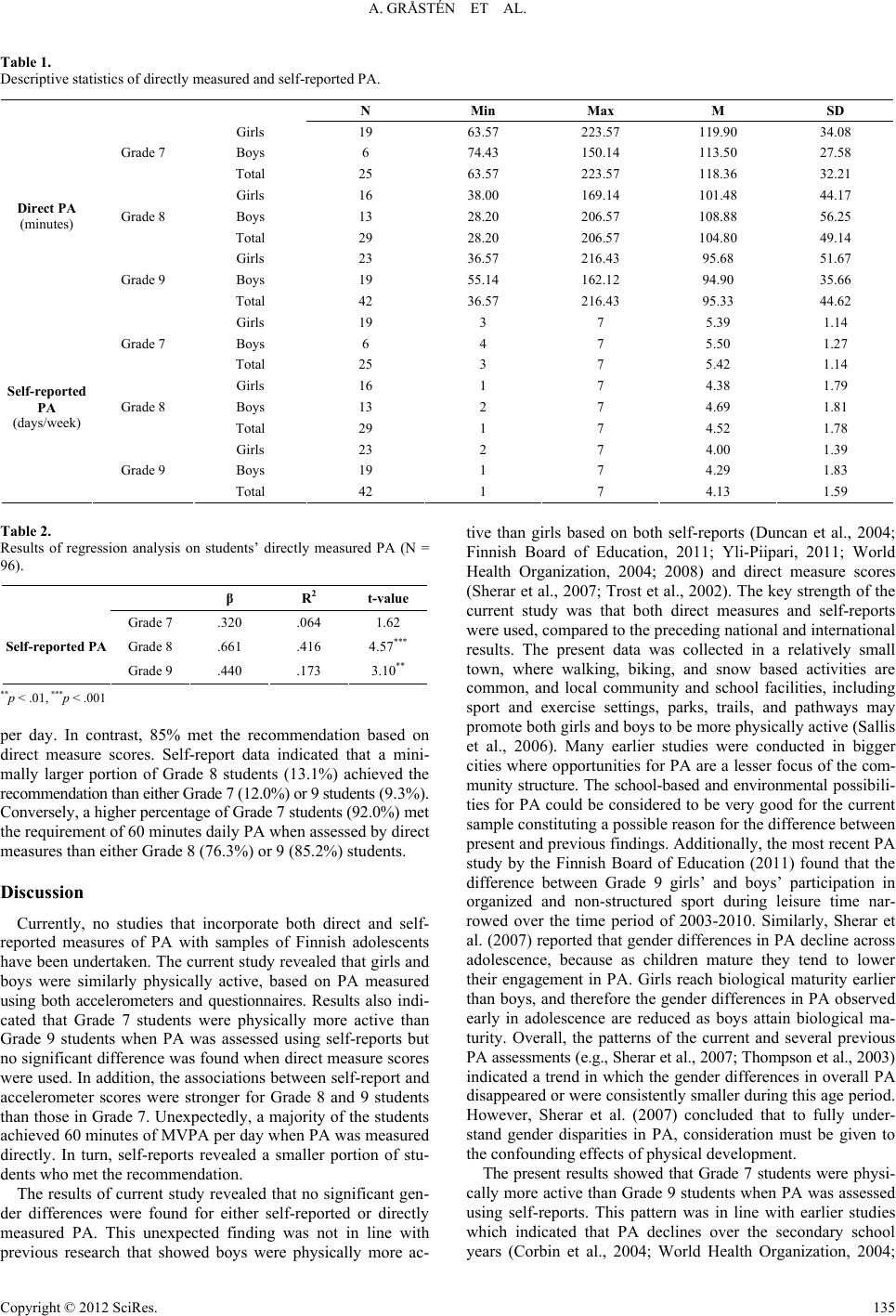 A. GRÅSTÉN ET AL. Copyright © 2012 SciRes. 135 Table 1. Descriptive statistics of directly measured and self-reported PA. N Min Max M SD Girls 19 63.57 223.57 119.90 34.08 Boys 6 74.43 150.14 113.50 27.58 Grade 7 Total 25 63.57 223.57 118.36 32.21 Girls 16 38.00 169.14 101.48 44.17 Boys 13 28.20 206.57 108.88 56.25 Grade 8 Total 29 28.20 206.57 104.80 49.14 Girls 23 36.57 216.43 95.68 51.67 Boys 19 55.14 162.12 94.90 35.66 Direct PA (minutes) Grade 9 Total 42 36.57 216.43 95.33 44.62 Girls 19 3 7 5.39 1.14 Boys 6 4 7 5.50 1.27 Grade 7 Total 25 3 7 5.42 1.14 Girls 16 1 7 4.38 1.79 Boys 13 2 7 4.69 1.81 Grade 8 Total 29 1 7 4.52 1.78 Girls 23 2 7 4.00 1.39 Boys 19 1 7 4.29 1.83 Self-reported PA (days/week) Grade 9 Total 42 1 7 4.13 1.59 Table 2. Results of regression analysis on students’ directly measured PA (N = 96). β R 2 t-value Grade 7 .320 .064 1.62 Grade 8 .661 .416 4.57*** Self-reported PA Grade 9 .440 .173 3.10** **p < .01, ***p < .001 per day. In contrast, 85% met the recommendation based on direct measure scores. Self-report data indicated that a mini- mally larger portion of Grade 8 students (13.1%) achieved the recommendation than either Grade 7 (12.0%) or 9 students (9.3%). Conversely, a higher percentage of Grade 7 students (92.0%) met the requirement of 60 minutes daily PA when assessed by direct measures than either Grade 8 (76.3%) or 9 (85.2%) students. Discussion Currently, no studies that incorporate both direct and self- reported measures of PA with samples of Finnish adolescents have been undertaken. The current study revealed that girls and boys were similarly physically active, based on PA measured using both accelerometers and questionnaires. Results also indi- cated that Grade 7 students were physically more active than Grade 9 students when PA was assessed using self-reports but no significant difference was found when direct measure scores were used. In addition, the associations between self-report and accelerometer scores were stronger for Grade 8 and 9 students than those in Grade 7. Unexpectedly, a majority of the students achieved 60 minutes of MVPA per day when PA was measured directly. In turn, self-reports revealed a smaller portion of stu- dents who met the recommendation. The results of current study revealed that no significant gen- der differences were found for either self-reported or directly measured PA. This unexpected finding was not in line with previous research that showed boys were physically more ac- tive than girls based on both self-reports (Duncan et al., 2004; Finnish Board of Education, 2011; Yli-Piipari, 2011; World Health Organization, 2004; 2008) and direct measure scores (Sherar et al., 2007; Trost et al., 2002). The key strength of the current study was that both direct measures and self-reports were used, compared to the preceding national and international results. The present data was collected in a relatively small town, where walking, biking, and snow based activities are common, and local community and school facilities, including sport and exercise settings, parks, trails, and pathways may promote both girls and boys to be more physically active (Sallis et al., 2006). Many earlier studies were conducted in bigger cities where opportunities for PA are a lesser focus of the com- munity structure. The school-based and environmental possibili- ties for PA could be considered to be very good for the current sample constituting a possible reason for the difference between present and previous findings. Additionally, the most recent PA study by the Finnish Board of Education (2011) found that the difference between Grade 9 girls’ and boys’ participation in organized and non-structured sport during leisure time nar- rowed over the time period of 2003-2010. Similarly, Sherar et al. (2007) reported that gender differences in PA decline across adolescence, because as children mature they tend to lower their engagement in PA. Girls reach biological maturity earlier than boys, and therefore the gender differences in PA observed early in adolescence are reduced as boys attain biological ma- turity. Overall, the patterns of the current and several previous PA assessments (e.g., Sherar et al., 2007; Thompson et al., 2003) indicated a trend in which the gender differences in overall PA disappeared or were consistently smaller during this age period. However, Sherar et al. (2007) concluded that to fully under- stand gender disparities in PA, consideration must be given to the confounding effects of physical development. The present results showed that Grade 7 students were physi- cally more active than Grade 9 students when PA was assessed using self-reports. This pattern was in line with earlier studies which indicated that PA declines over the secondary school years (Corbin et al., 2004; World Health Organization, 2004; 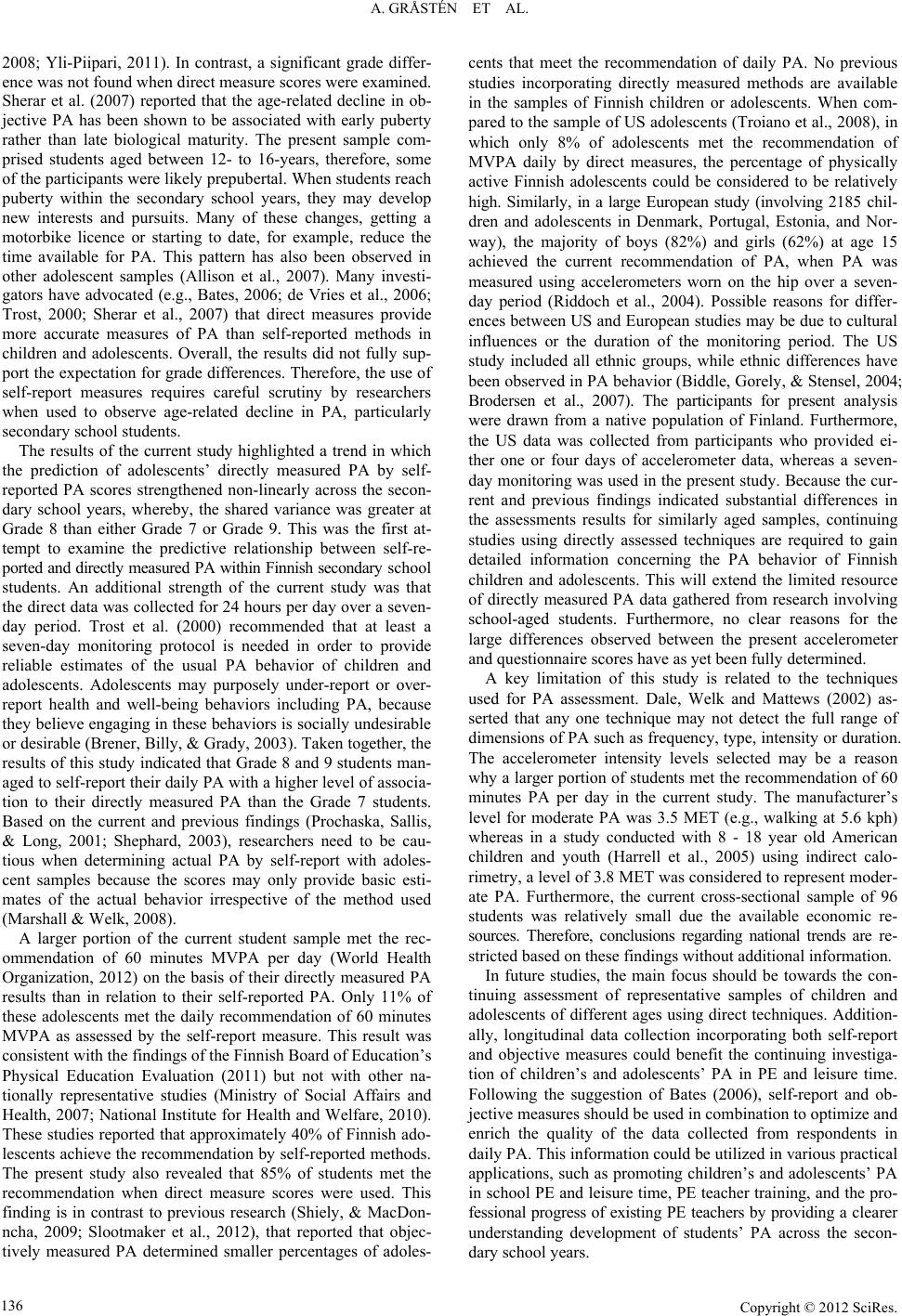 A. GRÅSTÉN ET AL. 2008; Yli-Piipari, 2011). In contrast, a significant grade differ- ence was not found when direct measure scores were examined. Sherar et al. (2007) reported that the age-related decline in ob- jective PA has been shown to be associated with early puberty rather than late biological maturity. The present sample com- prised students aged between 12- to 16-years, therefore, some of the participants were likely prepubertal. When students reach puberty within the secondary school years, they may develop new interests and pursuits. Many of these changes, getting a motorbike licence or starting to date, for example, reduce the time available for PA. This pattern has also been observed in other adolescent samples (Allison et al., 2007). Many investi- gators have advocated (e.g., Bates, 2006; de Vries et al., 2006; Trost, 2000; Sherar et al., 2007) that direct measures provide more accurate measures of PA than self-reported methods in children and adolescents. Overall, the results did not fully sup- port the expectation for grade differences. Therefore, the use of self-report measures requires careful scrutiny by researchers when used to observe age-related decline in PA, particularly secondary school students. The results of the current study highlighted a trend in which the prediction of adolescents’ directly measured PA by self- reported PA scores strengthened non-linearly across the secon- dary school years, whereby, the shared variance was greater at Grade 8 than either Grade 7 or Grade 9. This was the first at- tempt to examine the predictive relationship between self-re- ported and directly measured PA within Finnish secondary school students. An additional strength of the current study was that the direct data was collected for 24 hours per day over a seven- day period. Trost et al. (2000) recommended that at least a seven-day monitoring protocol is needed in order to provide reliable estimates of the usual PA behavior of children and adolescents. Adolescents may purposely under-report or over- report health and well-being behaviors including PA, because they believe engaging in these behaviors is socially undesirable or desirable (Brener, Billy, & Grady, 2003). Taken together, the results of this study indicated that Grade 8 and 9 students man- aged to self-report their daily PA with a higher level of associa- tion to their directly measured PA than the Grade 7 students. Based on the current and previous findings (Prochaska, Sallis, & Long, 2001; Shephard, 2003), researchers need to be cau- tious when determining actual PA by self-report with adoles- cent samples because the scores may only provide basic esti- mates of the actual behavior irrespective of the method used (Marshall & Welk, 2008). A larger portion of the current student sample met the rec- ommendation of 60 minutes MVPA per day (World Health Organization, 2012) on the basis of their directly measured PA results than in relation to their self-reported PA. Only 11% of these adolescents met the daily recommendation of 60 minutes MVPA as assessed by the self-report measure. This result was consistent with the findings of the Finnish Board of Education’s Physical Education Evaluation (2011) but not with other na- tionally representative studies (Ministry of Social Affairs and Health, 2007; National Institute for Health and Welfare, 2010). These studies reported that approximately 40% of Finnish ado- lescents achieve the recommendation by self-reported methods. The present study also revealed that 85% of students met the recommendation when direct measure scores were used. This finding is in contrast to previous research (Shiely, & MacDon- ncha, 2009; Slootmaker et al., 2012), that reported that objec- tively measured PA determined smaller percentages of adoles- cents that meet the recommendation of daily PA. No previous studies incorporating directly measured methods are available in the samples of Finnish children or adolescents. When com- pared to the sample of US adolescents (Troiano et al., 2008), in which only 8% of adolescents met the recommendation of MVPA daily by direct measures, the percentage of physically active Finnish adolescents could be considered to be relatively high. Similarly, in a large European study (involving 2185 chil- dren and adolescents in Denmark, Portugal, Estonia, and Nor- way), the majority of boys (82%) and girls (62%) at age 15 achieved the current recommendation of PA, when PA was measured using accelerometers worn on the hip over a seven- day period (Riddoch et al., 2004). Possible reasons for differ- ences between US and European studies may be due to cultural influences or the duration of the monitoring period. The US study included all ethnic groups, while ethnic differences have been observed in PA behavior (Biddle, Gorely, & Stensel, 2004; Brodersen et al., 2007). The participants for present analysis were drawn from a native population of Finland. Furthermore, the US data was collected from participants who provided ei- ther one or four days of accelerometer data, whereas a seven- day monitoring was used in the present study. Because the cur- rent and previous findings indicated substantial differences in the assessments results for similarly aged samples, continuing studies using directly assessed techniques are required to gain detailed information concerning the PA behavior of Finnish children and adolescents. This will extend the limited resource of directly measured PA data gathered from research involving school-aged students. Furthermore, no clear reasons for the large differences observed between the present accelerometer and questionnaire scores have as yet been fully determined. A key limitation of this study is related to the techniques used for PA assessment. Dale, Welk and Mattews (2002) as- serted that any one technique may not detect the full range of dimensions of PA such as frequency, type, intensity or duration. The accelerometer intensity levels selected may be a reason why a larger portion of students met the recommendation of 60 minutes PA per day in the current study. The manufacturer’s level for moderate PA was 3.5 MET (e.g., walking at 5.6 kph) whereas in a study conducted with 8 - 18 year old American children and youth (Harrell et al., 2005) using indirect calo- rimetry, a level of 3.8 MET was considered to represent moder- ate PA. Furthermore, the current cross-sectional sample of 96 students was relatively small due the available economic re- sources. Therefore, conclusions regarding national trends are re- stricted based on these findings without additional information. In future studies, the main focus should be towards the con- tinuing assessment of representative samples of children and adolescents of different ages using direct techniques. Addition- ally, longitudinal data collection incorporating both self-report and objective measures could benefit the continuing investiga- tion of children’s and adolescents’ PA in PE and leisure time. Following the suggestion of Bates (2006), self-report and ob- jective measures should be used in combination to optimize and enrich the quality of the data collected from respondents in daily PA. This information could be utilized in various practical applications, such as promoting children’s and adolescents’ PA in school PE and leisure time, PE teacher training, and the pro- fessional progress of existing PE teachers by providing a clearer understanding development of students’ PA across the secon- dary school years. Copyright © 2012 SciRes. 136 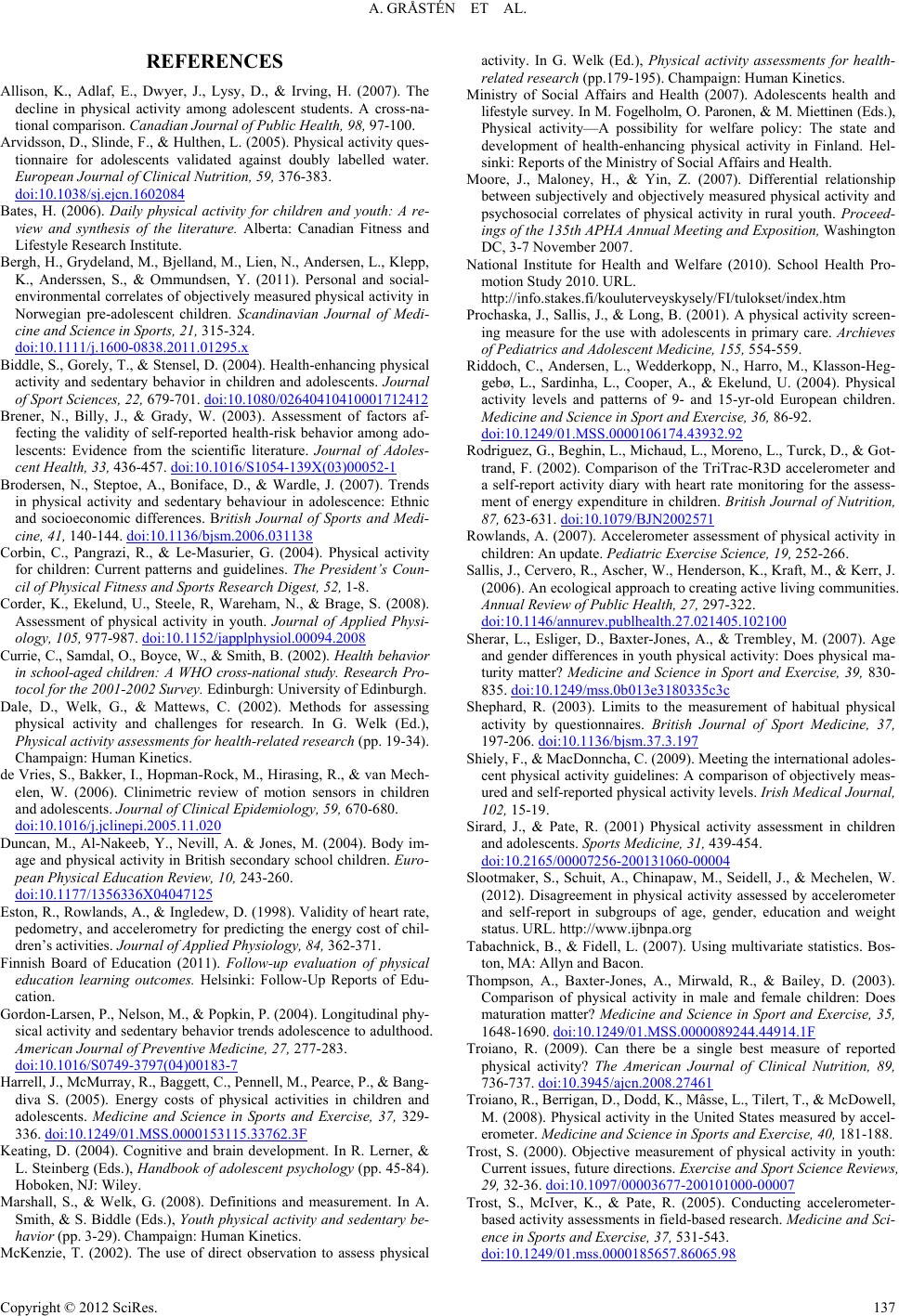 A. GRÅSTÉN ET AL. REFERENCES Allison, K., Adlaf, E., Dwyer, J., Lysy, D., & Irving, H. (2007). The decline in physical activity among adolescent students. A cross-na- tional comparison. Canadian Journal of Public Health, 98, 97-100. Arvidsson, D., Slinde, F., & Hulthen, L. (2005). Physical activity ques- tionnaire for adolescents validated against doubly labelled water. European Journal of Clinical Nutrit ion, 59, 376-383. doi:10.1038/sj.ejcn.1602084 Bates, H. (2006). Daily physical activity for children and youth: A re- view and synthesis of the literature. Alberta: Canadian Fitness and Lifestyle Research Institute. Bergh, H., Grydeland, M., Bjelland, M., Lien, N., Andersen, L., Klepp, K., Anderssen, S., & Ommundsen, Y. (2011). Personal and social- environmental correlates of objectively measured physical activity in Norwegian pre-adolescent children. Scandinavian Journal of Medi- cine and Science in Sports, 2 1 , 315-324. doi:10.1111/j.1600-0838.2011.01295.x Biddle, S., Gorely, T., & Stensel, D. (2004). Health-enhancing physical activity and sedentary behavior in children and adolescents. Journal of Sport Sciences, 22, 679-701. doi:10.1080/02640410410001712412 Brener, N., Billy, J., & Grady, W. (2003). Assessment of factors af- fecting the validity of self-reported health-risk behavior among ado- lescents: Evidence from the scientific literature. Journal of Adoles- cent Health, 33, 436-457. doi:10.1016/S1054-139X(03)00052-1 Brodersen, N., Steptoe, A., Boniface, D., & Wardle, J. (2007). Trends in physical activity and sedentary behaviour in adolescence: Ethnic and socioeconomic differences. British Journal of Sports and Medi- cine, 41, 140-144. doi:10.1136/bjsm.2006.031138 Corbin, C., Pangrazi, R., & Le-Masurier, G. (2004). Physical activity for children: Current patterns and guidelines. The President’s Coun- cil of Physical Fitness and Sports Research D i gest, 52, 1-8. Corder, K., Ekelund, U., Steele, R, Wareham, N., & Brage, S. (2008). Assessment of physical activity in youth. Journal of Applied Physi- ology, 105, 977-987. doi:10.1152/japplphysiol.00094.2008 Currie, C., Samdal, O., Boyce, W., & Smith, B. (2002). Health behavior in school-aged children: A WHO cross-national study. Research Pro- tocol for the 2001-2002 Survey. Edinburgh: University of Edinburgh. Dale, D., Welk, G., & Mattews, C. (2002). Methods for assessing physical activity and challenges for research. In G. Welk (Ed.), Physical activity assessments for health-related research (pp. 19-34). Champaign: Human Kinetics. de Vries, S., Bakker, I., Hopman-Rock, M., Hirasing, R., & van Mech- elen, W. (2006). Clinimetric review of motion sensors in children and adolescents. Journal of Clinical Epidemiology, 59, 670-680. doi:10.1016/j.jclinepi.2005.11.020 Duncan, M., Al-Nakeeb, Y., Nevill, A. & Jones, M. (2004). Body im- age and physical activity in British secondary school children. Euro- pean Physical Education Review, 10, 243-260. doi:10.1177/1356336X04047125 Eston, R., Rowlands, A., & Ingledew, D. (1998). Validity of heart rate, pedometry, and accelerometry for predicting the energy cost of chil- dren’s activities. Journal of Applied Physiology, 84, 362-371. Finnish Board of Education (2011). Follow-up evaluation of physical education learning outcomes. Helsinki: Follow-Up Reports of Edu- cation. Gordon-Larsen, P., Nelson, M., & Popkin, P. (2004). Longitudinal phy- sical activity and sedentary behavior trends adolescence to adulthood. American Journal of Preventive Medicine, 27, 277-283. doi:10.1016/S0749-3797(04)00183-7 Harrell, J., McMurray, R., Baggett, C., Pennell, M., Pearce, P., & Bang- diva S. (2005). Energy costs of physical activities in children and adolescents. Medicine and Science in Sports and Exercise, 37, 329- 336. doi:10.1249/01.MSS.0000153115.33762.3F Keating, D. (2004). Cognitive and brain development. In R. Lerner, & L. Steinberg (Eds.), Handbook of adolescent psychology (pp. 45-84). Hoboken, NJ: Wiley. Marshall, S., & Welk, G. (2008). Definitions and measurement. In A. Smith, & S. Biddle (Eds.), Youth physical activity and sedentary be- havior (pp. 3-29). Champaign: Human Kinetics. McKenzie, T. (2002). The use of direct observation to assess physical activity. In G. Welk (Ed.), Physical activity assessments for health- related research (pp.179-195). Champaign: Human Kinetics. Ministry of Social Affairs and Health (2007). Adolescents health and lifestyle survey. In M. Fogelholm, O. Paronen, & M. Miettinen (Eds.), Physical activity—A possibility for welfare policy: The state and development of health-enhancing physical activity in Finland. Hel- sinki: Reports of the Ministry of Social Affairs and Health. Moore, J., Maloney, H., & Yin, Z. (2007). Differential relationship between subjectively and objectively measured physical activity and psychosocial correlates of physical activity in rural youth. Proceed- ings of the 135th APHA Annual Meeting and Exposition, Washington DC, 3-7 November 2007. National Institute for Health and Welfare (2010). School Health Pro- motion Study 2010. URL. http://info.stakes.fi/kouluterveyskysely/FI/tulokset/index.htm Prochaska, J., Sallis, J., & Long, B. (2001). A physical activity screen- ing measure for the use with adolescents in primary care. Archieves of Pediatrics and Adolescent Medicine, 155, 554-559. Riddoch, C., Andersen, L., Wedderkopp, N., Harro, M., Klasson-Heg- gebø, L., Sardinha, L., Cooper, A., & Ekelund, U. (2004). Physical activity levels and patterns of 9- and 15-yr-old European children. Medicine and Science in Sport and Exercise, 36, 86-92. doi:10.1249/01.MSS.0000106174.43932.92 Rodriguez, G., Beghin, L., Michaud, L., Moreno, L., Turck, D., & Got- trand, F. (2002). Comparison of the TriTrac-R3D accelerometer and a self-report activity diary with heart rate monitoring for the assess- ment of energy expenditure in children. British Journal of Nutrition, 87, 623-631. doi:10.1079/BJN2002571 Rowlands, A. (2007). Accelerometer assessment of physical activity in children: An update. Pediatric Exercise Science, 19, 252-266. Sallis, J., Cervero, R., Ascher, W., Henderson, K., Kraft, M., & Kerr, J. (2006). An ecological approach to creating active living communities. Annual Review of Public H e alth, 27, 297-322. doi:10.1146/annurev.publhealth.27.021405.102100 Sherar, L., Esliger, D., Baxter-Jones, A., & Trembley, M. (2007). Age and gender differences in youth physical activity: Does physical ma- turity matter? Medicine and Science in Sport and Exercise, 39, 830- 835. doi:10.1249/mss.0b013e3180335c3c Shephard, R. (2003). Limits to the measurement of habitual physical activity by questionnaires. British Journal of Sport Medicine, 37, 197-206. doi:10.1136/bjsm.37.3.197 Shiely, F., & MacDonncha, C. (2009). Meeting the international adoles- cent physical activity guidelines: A comparison of objectively meas- ured and self-reported physical activity levels. Irish Medical Journal, 102, 15-19. Sirard, J., & Pate, R. (2001) Physical activity assessment in children and adolescents. Sports Medicine, 31, 439-454. doi:10.2165/00007256-200131060-00004 Slootmaker, S., Schuit, A., Chinapaw, M., Seidell, J., & Mechelen, W. (2012). Disagreement in physical activity assessed by accelerometer and self-report in subgroups of age, gender, education and weight status. URL. http://www.ijbnpa.org Tabachnick, B., & Fidell, L. (2007). Using multivariate statistics. Bos- ton, MA: Allyn and Bacon. Thompson, A., Baxter-Jones, A., Mirwald, R., & Bailey, D. (2003). Comparison of physical activity in male and female children: Does maturation matter? Medicine and Science in Sport and Exercise, 35, 1648-1690. doi:10.1249/01.MSS.0000089244.44914.1F Troiano, R. (2009). Can there be a single best measure of reported physical activity? The American Journal of Clinical Nutrition, 89, 736-737. doi:10.3945/ajcn.2008.27461 Troiano, R., Berrigan, D., Dodd, K., Mâsse, L., Tilert, T., & McDowell, M. (2008). Physical activity in the United States measured by accel- erometer. Medicine and Science in Sports and Exerc i s e , 40, 181-188. Trost, S. (2000). Objective measurement of physical activity in youth: Current issues, future directions. Exercise and Sport Science Reviews, 29, 32-36. doi:10.1097/00003677-200101000-00007 Trost, S., McIver, K., & Pate, R. (2005). Conducting accelerometer- based activity assessments in field-based research. Medicine and Sci- ence in Sports and Exe r c i s e, 3 7 , 531-543. doi:10.1249/01.mss.0000185657.86065.98 Copyright © 2012 SciRes. 137 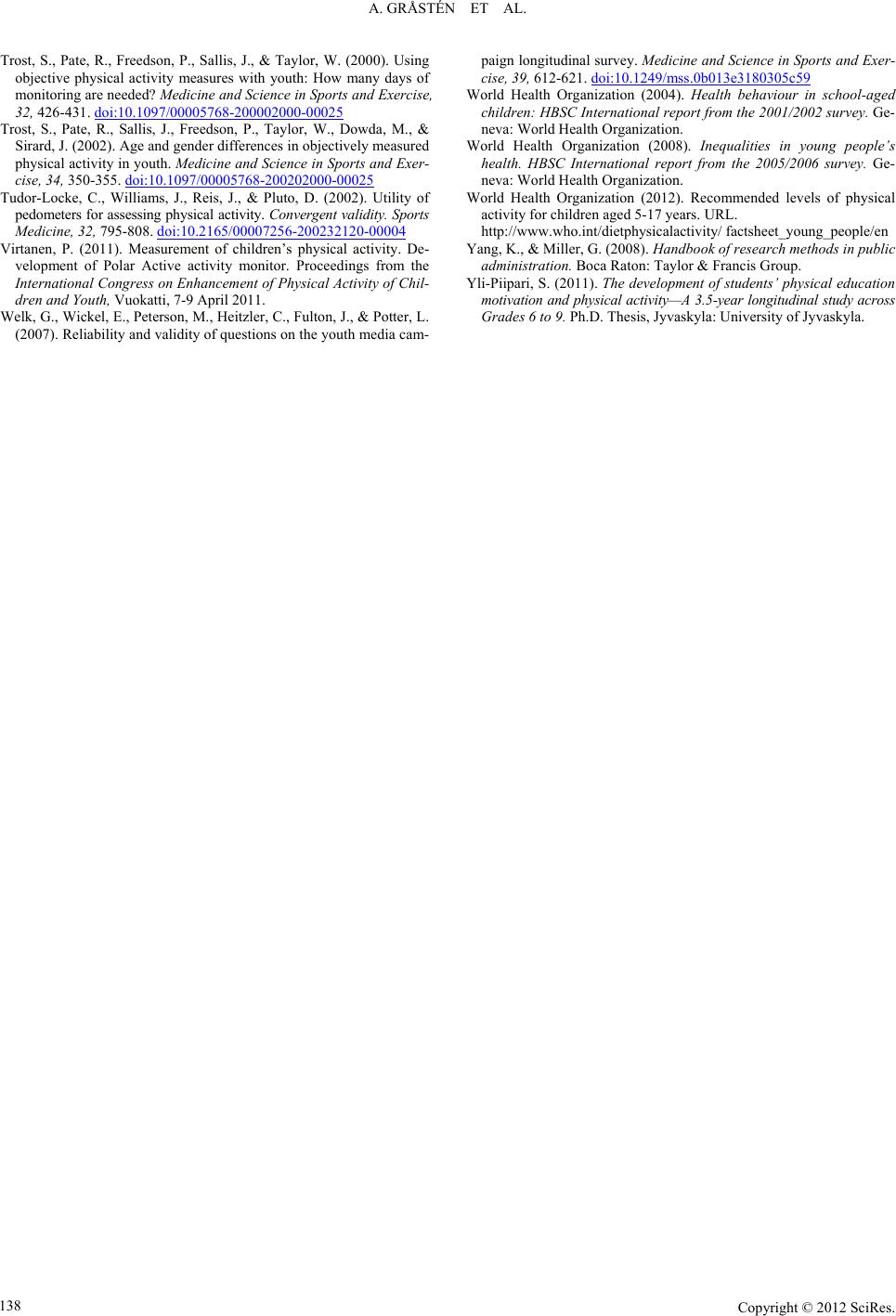 A. GRÅSTÉN ET AL. Copyright © 2012 SciRes. 138 Trost, S., Pate, R., Freedson, P., Sallis, J., & Taylor, W. (2000). Using objective physical activity measures with youth: How many days of monitoring are needed? Medicine and Science in Sports and Exercise, 32, 426-431. doi:10.1097/00005768-200002000-00025 Trost, S., Pate, R., Sallis, J., Freedson, P., Taylor, W., Dowda, M., & Sirard, J. (2002). Age and gender differences in objectively measured physical activity in youth. Medicine and Science in Sports and Exer- cise, 34, 350-355. doi:10.1097/00005768-200202000-00025 Tudor-Locke, C., Williams, J., Reis, J., & Pluto, D. (2002). Utility of pedometers for assessing physical activity. Convergent validity. Sports Medicine, 32, 795-808. doi:10.2165/00007256-200232120-00004 Virtanen, P. (2011). Measurement of children’s physical activity. De- velopment of Polar Active activity monitor. Proceedings from the International Congress on Enhancement of Physical Activity of Chil- dren and Youth, Vuokatti, 7-9 April 2011. Welk, G., Wickel, E., Peterson, M., Heitzler, C., Fulton, J., & Potter, L. (2007). Reliability and validity of questions on the youth media cam- paign longitudinal survey. Medicine and Science in Sports and Exer- cise, 39, 612-621. doi:10.1249/mss.0b013e3180305c59 World Health Organization (2004). Health behaviour in school-aged children: HBSC International report from the 2001/2002 survey. Ge- neva: World Health Organization. World Health Organization (2008). Inequalities in young people’s health. HBSC International report from the 2005/2006 survey. Ge- neva: World Health Organization. World Health Organization (2012). Recommended levels of physical activity for children aged 5-17 years. URL. http://www.who.int/dietphysicalactivity/ factsheet_young_people/en Yang, K., & Miller, G. (2008). Handbook of research methods i n p u bl i c administration. Boca Raton: Taylor & Francis Group. Yli-Piipari, S. (2011). The development of students’ physical education motivation and physical activity—A 3.5-year longitudinal study across Grades 6 to 9. Ph.D. Thesis, Jyvaskyla: University of Jyvaskyla.
|